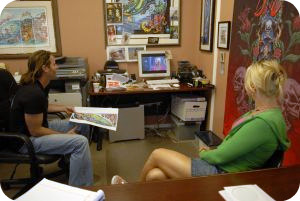“Money is better than poverty, if only for financial reasons.” Woody Allen
Being “ripped off”. I really don’t like the negative sound of those words. But I’m compelled to write about it because it’s a topic that comes up again and again.
Yesterday an artist was in my office and she said that she’s been stiffed on payment too many times to mention. It’s worn her down and she feels unappreciated.
Getting stiffed on payment is sadly one of the most common and frustrating things that can happen to freelancers. It happens to artists, photographers, filmmakers, web designers and just about every small business owner at one time or another.
But it doesn’t have to ever happen to you (again). It’s very simple to avoid. You just have to do two things:
1.) Require a deposit up front
2.) Require the full balance at completion
The INSTANT you institute these two policies for your small business, you will NEVER have to make a collection call EVER again.
If it’s this simple, why do so many people continue to get “stiffed” on payment?
Because they don’t ask for the deposit up front and they hand over the goods before being paid. It’s too bad that art school doesn’t teach you the importance of running your art venture like a business.
Here are some of the most common excuses I hear from people who keep getting ripped off:
- “I don’t have a business mind”
- “I’m new at this”
- “I need an agent to do this for me.”
- “I needed the work really bad – I was desperate.”
Handling your business wisely is a decision you make, not a gene that you’re born with!
Please trust me when I say that YOU DO NOT HAVE TO HAVE BEEN BORN WITH A BUSINESS MIND TO AVOID BEING RIPPED OFF!
You just have to institute your own payment policies.
I learned this the hard way when, many moons ago, Drew was “hired” by the large clothing company American Eagle. They asked him to create a detailed artistic map of one of the Hawaiian Islands. The art was going to be used for t-shirts and other accessories.
They were on a tight deadline and needed it yesterday. There was no time to get a deposit. Drew put in many hours drawing this up, and the art director at American Eagle kept making changes.
Their final change is what led to the non-payment: They decided not to use a map after all. We sent them a bill for the work done, and they never paid us. Dealing with a company that large is nearly impossible to get payment from AFTER THE FACT. That’s why we should have gotten money up front.
We were, by some standards, ripped off, taken advantage of and screwed over.
But I’m a firm believer that no-one can take advantage of you without your consent.
It was our own fault for not getting money up front before Drew put in many hours of work.
That was the LAST TIME we ever got stiffed on a commissioned job. We learned from our mistake, and since then have required 50% up front and the balance when finished (before we hand the art over).
THE PSYCHOLOGY OF REQUIRING A DEPOSIT
Two important things happen when you say to your client: “I’ll need 50% up front to start the work and the balance is due when the work is completed.”
1 You are viewed as professional: Your client now sees you as a person who has payment policies in place. They respect you, and they are clear on what you expect and how it’s going to go.
2 A commitment is formed: Your client is fully committed when they pay a deposit.
When someone pays a deposit towards something, they are making a commitment to the project.
It’s a psychological thing. Without a deposit, there is no real commitment from your client. It’s like buying plane tickets. My trip to New Zealand last year was just talk until I plunked down the $1,800 for plane tickets. Once that money was paid, it was a reality. We were fully committed.
HOW MUCH OF A DEPOSIT SHOULD YOU ASK FOR?
Many artists require 50% up front. The average, according to the Graphic Artists Guide to Ethical Pricing, is 30%. I prefer the 50% and so does my bank account.
HOW DO YOU ASK FOR A DEPOSIT?
In every conversation I have with a new client, I mention, up front (even with friends and acquaintances and my mother’s uncle’s niece) that we need a deposit to get started. (Hate to say it, but sometimes it’s the people closest to you that will stiff you).
You may feel strange asking for this. Get over it, do it, and you’ll get used to it and eventually it won’t feel strange anymore. Learning how to walk was strange also. But you got used to it.
When giving a price quote, include your deposit requirement in writing by e-mail or proposal. Here’s how ours looks in a price quote (I grabbed this from an actual proposal for a wakeboard design we did earlier this year):
PRICING: Fee is $3,800.00. A 50% deposit is required to start the work, and full balance upon completion. OPTIONAL: Original artwork may be purchased within 30 days of completion at a greatly discounted price of $3,500. (Payments shall be made to Son of the Sea, Inc. PO Box 836, San Clemente, CA 92674.)
And here’s what we put in e-mails sent to clients with big projects, like murals:
We must have your signed proposal and deposit for the mural painting NO LATER THAN 2 weeks prior to the start date. This allows us to get the materials we need at the pricing we configured for your quote.
Over time, your returning customers will know what you expect and they will be prepared to write you a check for the deposit. All of our longtime customers are used to the way we work. They also know that the work will get done to their satisfaction, because they’ve worked with us before.
RESISTANCE TO PAYING A DEPOSIT COMES FROM CLIENTS AND ARTISTS:
It’s not always the client feeling weird about a deposit. Sometimes it’s the artist. Here are some of the scenarios:
THE ARTIST DOESN’T REQUIRE IT BECAUSE THEY ARE DESPERATE FOR THE WORK: If you are desperate for work, than you surely cannot afford to spend time on something that you’ll never get paid for. A deposit weeds out the payers from the non-payers. The people who most likely will never pay you are the ones who won’t give a deposit. The people willing to give a deposit are the ones that are serious. See how this works?!
THE CLIENT REFUSES TO PAY A DEPOSIT: If a client won’t pay a deposit, they just aren’t ready to commit. If that’s the case, than you shouldn’t commit your time to their project.
Don’t get mad. Just let them know that you are happy to start the work after they pay. Tell them to call you when they are ready. Be friendly and professional.
THEY DON’T HAVE THE MONEY: I’ve run into this many times: When I tell someone that they have to pay a deposit, and then they say “Oh, I don’t have the money right now.” This tells me that they may never have it. So I say “When you do, let me know. We are looking forward to working with you.”
YOU FEEL YOU HAVE TO PROVE YOURSELF BEFORE YOU CAN DEMAND A DEPOSIT: If you’ve been at it for less than 2 years you may still have to prove yourself before you can require a 30% – 50% deposit. Maybe the client isn’t sure of your abilities and they are nervous to trust you. In this case, lower the amount you ask for to 20% instead.
YOUR CLIENT IS A HUGE 5 BILLION DOLLAR COMPANY AND THEY TAKE 3 WEEKS TO CUT CHECKS BUT NEED YOU TO FINISH IN 2 WEEKS: I’ve been faced with this scenario a few times. Here’s what I do: I ask the client to write me a personal check and they can bill their company for it later. Some people laugh at that, but the serious ones send me their personal check.
THEY FLAT OUT REFUSE: If they just refuse to pay a deposit, than most likely you’ll never get paid, no matter what you do, because of a lack of commitment on their part. So walk away. You’ll save yourself a lot of wasted time and frustration.
IF YOU’VE BEEN A PROFESSIONAL AT YOUR TRADE FOR OVER FIVE YEARS: You can STOP proving yourself. No one should question you at this point. You have good references that the client can call if they doubt your abilities.
EXCEPTIONS TO THE RULES: Of course, there are exceptions to every rule. We made an exception when we did a deal with Converse – Drew started the work before we got our deposit. They took 6 weeks to cut us a check. But we have a good relationship with our people there, and I knew they would take care of us. I very rarely make the exception, because of being burned in the past.
LEARN FROM YOUR MISTAKES
If you’ve been “ripped off” more than a couple times, than you need to look in the mirror and ask yourself what you’re doing to cause this. Analyze what’s happening – are you keeping your end of the bargain? Do you meet your deadlines? Are you a joy to work with? Do you behave like a professional? It’s important to learn from our mistakes and then change the way we do things if something isn’t working.
I read somewhere once that the definition of crazy person is: Someone who keeps doing the same thing over and over again but expecting a different result!
SIMPLE RULES FOR PRICING:
If you follow these simple guidelines, you’ll never have a problem getting paid:
Put your price quote in writing (e-mail is fine) – this way there are no surprises on either end. Give your quote leeway to add to it in the event that the scope of the work changes. (We do this by adding this sentence: In the event of unforeseen additional work due to conditions on surface or changes to the design by the client that may require extra labor or detail, this price could change.)
Have a payment policy and include that in your price quote (i.e. 50% down and balance due at completion)
Put a 30 day limit on your price quote – your situation could change or your materials costs can go up. On my proposals I’ll put: Proposal Date May 27, 2010. Proposal valid for 30 days
Don’t begin the work without a commitment from your client in the form of a deposit
Send your client frequent updates of the progress of the work, along with photos of the progression. This will give your client satisfaction knowing that you are working on it and that it’s getting done.
When it’s finished, send them a photo of the completed work and arrange to get final payment at the same time you hand over the goods.
I sincerely hope this article convinces all of you out there to institute your own policies. Even if you are a part-time freelance artist or photographer, you are in business. Your time is valuable. You should be paid for your work.
Please, in the comments below, let me know what problems you’ve had on this subject and how you’ve dealt with it!
Maria xxoo
.















